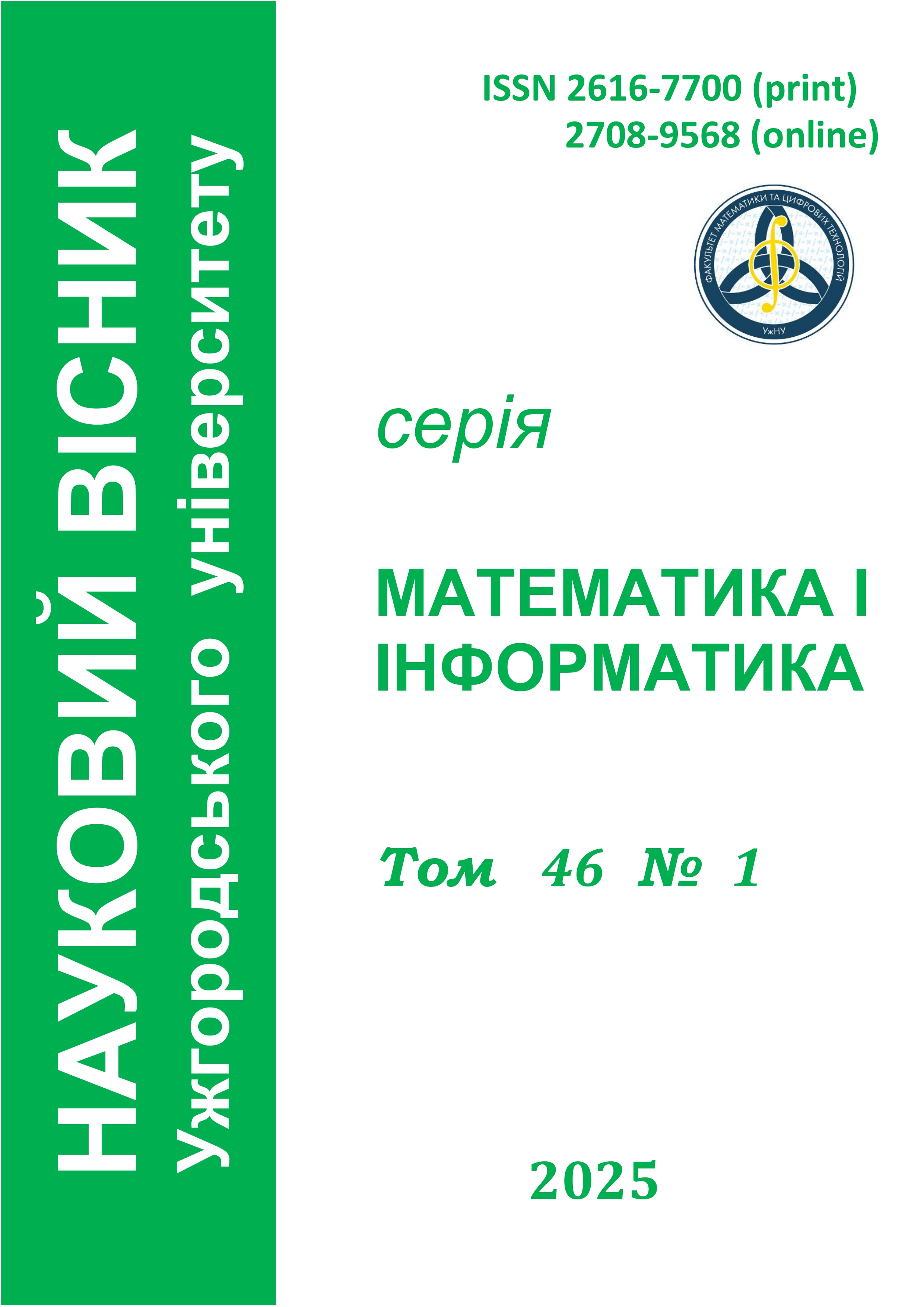Розробка інтелектуальної системи прийняття рішень для діагностування діабету
DOI:
https://doi.org/10.24144/2616-7700.2025.46(1).226-233Ключові слова:
система прийняття рішень, класифікація, діагностування діабету, інтелектуальна система, машинне навчанняАнотація
У статті представлено результати розробки інтелектуальної системи підтримки прийняття рішень для діагностики цукрового діабету з використанням методів машинного навчання. На основі відкритого медичного датасету було побудовано та проаналізовано низку класифікаційних моделей, зокрема логістичну регресію, Random Forest та XGBoost. З метою підвищення точності було застосовано метод стратифікації при виділенні валідаційних даних, масштабування ознак, крос-валідацію та оптимізацію гіперпараметрів моделей. Особливу увагу приділено аналізу матриць невідповідності та оцінці впливу ключових ознак. Найкраща кросвалідаційна точність досягнута моделлю Random Forest (94.43%), що свідчить про її здатність добре узагальнювати закономірності у незбалансованих даних. Найнижча кількість помилок другого роду (FN = 16) спостерігається в моделі XGBoost. Запропонований підхід може бути ефективно використаний для попереднього діагностування діабету.
Посилання
- Rabie, O., Alghazzawi, D., Asghar, J., Saddozai, F. K., & Asghar, M. Z. (2022). A decision support system for diagnosing diabetes using deep neural network. Frontiers in Public Health, 10, 861062. https://doi.org/10.3389/fpubh.2022.861062
- Tuppad, A., & Patil, S. D. (2022). Machine learning for diabetes clinical decision support: A review. Advances in Computational Intelligence, 2(2), 22. https://doi.org/10.1007/s43674-022-00034-y
- Omana, J., & Moorthi, M. (2022). Predictive analysis and prognostic approach of diabetes prediction with machine learning techniques. Wireless Personal Communications, 127(1), 465–478. https://doi.org/10.1007/s11277-021-08274-w
- Gupta, H., Varshney, H., Sharma, T. K., Pachauri, N., & Verma, O. P. (2022). Comparative performance analysis of quantum machine learning with deep learning for diabetes prediction. Complex & Intelligent Systems, 8(4), 3073–3087. https://doi.org/10.1007/s40747-021-00398-7
- Olowe, K. J., Edoh, N. L., Zouo, S. J. C., & Olamijuwon, J. (2024). Comprehensive review of logistic regression techniques in predicting health outcomes and trends. World Journal of Advanced Pharmaceutical and Life Sciences, 7(2), 16–26. https://doi.org/10.53346/wjapls.2024.7.2.0039
- Badawy, M., Ramadan, N., & Hefny, H. A. (2023). Healthcare predictive analytics using machine learning and deep learning techniques: A survey. Journal of Electrical Systems and Information Technology, 10(1), 40. https://doi.org/10.21203/rs.3.rs-1885746/v2
- Sievering, A. W., & others. (2022). Comparison of machine learning methods with logistic regression analysis in creating predictive models for risk of critical in-hospital events in COVID-19 patients on hospital admission. BMC Medical Informatics and Decision Making, 22(1), 309. https://doi.org/10.1186/s12911-022-02057-4
- Iranzad, R., & Liu, X. (2024). A review of random forest-based feature selection methods for data science education and applications. International Journal of Data Science and Analytics. Advance online publication. https://doi.org/10.1007/s41060-024-00509-w
- Palimkar, P., Shaw, R. N., & Ghosh, A. (2021). Machine learning technique to prognosis diabetes disease: Random forest classifier approach. In Advanced computing and intelligent technologies: Proceedings of ICACIT 2021. Springer: Singapore. https://doi.org/10.1007/978-981-16-2164-2_19
- Bentéjac, C., Csörgő, A., & Martínez-Muñoz, G. (2021). A comparative analysis of gradient boosting algorithms. Artificial Intelligence Review, 54(3), 1937–1967. https://doi.org/10.1007/s10462-020-09896-5
- Zhang, P., Jia, Y., & Shang, Y. (2022). Research and application of XGBoost in imbalanced data. International Journal of Distributed Sensor Networks, 18(6). https://doi.org/10.1177/1550132922110693
- Darabi, P. K. (2023). Diabetes dataset with 18 features. [Data set]. Kaggle. Retrieved from https://www.kaggle.com/datasets/pkdarabi/diabetes-dataset-with-18-features
- Kondruk, N. E. (2023). Analysis of dimensionality reduction techniques in machine learning. Scientific Bulletin of Uzhhorod University, Series "Mathematics and Informatics", 42(1), 181–187. https://doi.org/10.24144/2616-7700.2023.42(1).181-187
##submission.downloads##
Опубліковано
Як цитувати
Номер
Розділ
Ліцензія
Авторське право (c) 2025 М. М. Маляр, Н. Е. Кондрук, Є. Б. Кондрук, В. А. Нерода

Ця робота ліцензується відповідно до Creative Commons Attribution 4.0 International License.
Автори залишають за собою право на авторство своєї роботи та передають журналу право першої публікації цієї роботи на умовах ліцензії Creative Commons Attribution License, котра дозволяє іншим особам вільно розповсюджувати опубліковану роботу з обов'язковим посиланням на авторів оригінальної роботи та першу публікацію роботи у цьому журналі.








